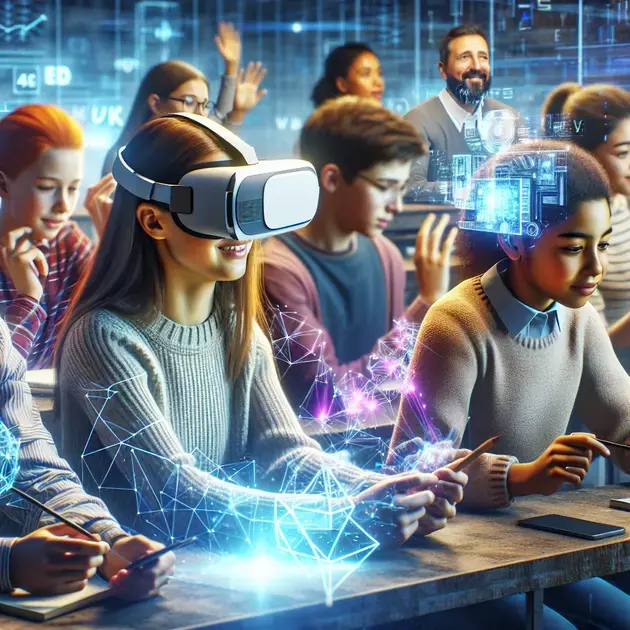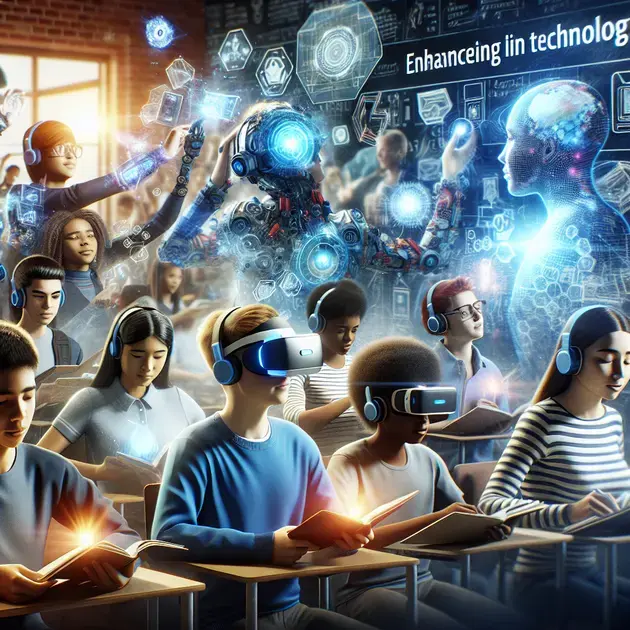Educational technology has been revolutionizing the way students learn, providing innovative tools and resources to enhance their educational experience. With the constant evolution of technology, educators are finding new and creative ways to integrate it into the classroom. From virtual reality to interactive whiteboards, these tools aim to engage students and make learning more interactive and effective.
One of the key benefits of enhancing learning with educational technology is the ability to personalize the learning experience for each student. Adaptive learning platforms can analyze individual learning styles and performance data to provide customized learning paths. This personalized approach not only fosters student engagement but also helps improve learning outcomes.

Enhancing Learning with Technology Benefits
Technology offers numerous benefits for enhancing the learning experience. One of the key advantages is the ability to access a vast amount of information instantly. With educational apps like Khan Academy or Coursera, students can have access to a wide range of educational materials, including tutorials, videos, and interactive quizzes. This helps them deepen their understanding of various subjects and concepts.
Another benefit of technology in learning is the opportunity for personalized learning experiences. Platforms like Duolingo or Quizlet allow students to set their own learning pace and receive customized feedback. This adaptive learning approach caters to individual student needs, ensuring a more effective and engaging learning process.
Collaborative learning is also greatly enhanced through technology. Tools like Google Drive or Microsoft Teams enable students to work together on projects in real time, regardless of their physical location. This promotes teamwork, communication skills, and the ability to share ideas and feedback seamlessly.
Furthermore, technology enhances accessibility for learners with disabilities. Apps like Voice Dream Reader or Seeing AI provide features such as text-to-speech and visual recognition, making learning more inclusive and equitable for all students. These assistive technologies help remove barriers to education and empower students with different learning needs.
Overall, the benefits of technology in learning are vast and impactful, revolutionizing the way students learn and interact with educational content.
Personalized Learning Experience with Educational Technology
Personalized learning is a crucial aspect of modern education, and educational technology plays a significant role in enabling personalized learning experiences. One innovative tool that facilitates personalized learning is Edmodo, a platform that allows teachers to create individualized learning paths for each student based on their learning style and pace.
Additionally, adaptive learning platforms like DreamBox or Knewton use artificial intelligence algorithms to provide students with personalized recommendations and content based on their strengths and weaknesses. This tailored approach ensures that students receive the support and resources they need to succeed.
Another way technology enhances personalized learning is through data analytics. Learning management systems like Canvas or Blackboard Learn track student progress and performance, allowing teachers to identify areas where students may need additional support or challenge. This data-driven approach enables educators to adjust their teaching strategies accordingly to meet the diverse needs of learners.
Furthermore, virtual reality tools such as Nearpod or ClassVR offer immersive learning experiences that cater to individual learning preferences. By engaging students in interactive simulations and virtual field trips, these tools create a dynamic and personalized learning environment that boosts student engagement and retention.
In conclusion, educational technology empowers educators to deliver personalized learning experiences that cater to the unique needs and preferences of each student, ultimately enhancing overall learning outcomes.
Innovative Tools for Interactive Learning
Interactive learning tools are essential for promoting student engagement and participation in the classroom. One innovative tool that fosters interactive learning is Pear Deck, a presentation platform that allows teachers to create interactive quizzes, polls, and discussions within their slides. This real-time feedback functionality encourages student involvement and collaboration.
Another effective tool for interactive learning is Flipgrid, a video discussion platform that enables students to share their thoughts and ideas through short videos. This creative approach enhances communication skills, critical thinking, and digital literacy, while also promoting a sense of community and belonging among students.
Gamification tools like Kahoot or Quizizz are also great for creating interactive learning experiences. These platforms allow teachers to turn traditional quizzes and assessments into engaging games, motivating students to participate and learn in a fun and competitive way. Gamified learning increases student motivation and retention of information.
Collaborative whiteboard tools such as Miro or Jamboard are excellent for promoting interactive group work and brainstorming sessions. These virtual whiteboards enable students to work together in real time, share ideas, and visualize concepts, fostering creativity, teamwork, and problem-solving skills.
Overall, incorporating innovative tools for interactive learning enhances student engagement, encourages active participation, and fosters a dynamic learning environment that stimulates curiosity and creativity.

Improving Student Engagement through Technology Integration
Technology integration in education plays a crucial role in enhancing student engagement both in and out of the classroom. By incorporating various digital tools and resources into the learning process, educators can create interactive and dynamic experiences that captivate students’ attention. One innovative way to achieve this is by utilizing virtual classrooms and online collaboration platforms to facilitate discussions, group projects, and real-time feedback.
Furthermore, the use of educational apps and gamified learning systems can make the learning experience more enjoyable and interactive for students. These tools not only cater to different learning styles but also provide instant feedback, progress tracking, and personalized learning paths based on individual strengths and weaknesses. By incorporating technology in such a way, educators can tailor the learning experience to meet the needs of each student, ultimately improving overall engagement and motivation.
In addition, the integration of multimedia resources such as videos, simulations, and interactive presentations can make complex concepts more accessible and understandable to students. Visual and interactive content not only stimulates interest but also enhances retention and comprehension. By leveraging technology to present information in various formats, educators can create a more immersive and engaging learning environment that sparks curiosity and encourages exploration.
Overall, technology integration empowers educators to design interactive and engaging learning experiences that foster student curiosity, critical thinking, and collaboration. By leveraging digital tools and resources effectively, educators can create a dynamic learning environment that motivates students to actively participate and take ownership of their learning journey.
Maximizing Student Achievement with Digital Learning Resources
Digital learning resources have revolutionized the way students access and engage with educational content, providing them with a wealth of resources to enhance their learning and maximize their academic achievement. By utilizing online platforms, e-books, interactive tutorials, and educational videos, students can supplement their traditional classroom learning with dynamic and accessible resources that cater to their individual needs and preferences.
One significant advantage of digital learning resources is their flexibility and accessibility, allowing students to learn at their own pace and revisit challenging concepts as needed. The interactive nature of digital resources also promotes active learning and engagement, as students can actively participate in quizzes, simulations, and virtual labs to reinforce their understanding of key concepts.
Moreover, the personalized nature of digital learning resources enables students to receive instant feedback on their progress, identify areas for improvement, and track their learning goals effectively. Adaptive learning platforms can also tailor content and learning activities based on students’ performance, ensuring that each student receives a customized learning experience that maximizes their academic potential.
By leveraging digital learning resources effectively, educators can empower students to take charge of their learning, develop critical thinking skills, and achieve academic excellence. The combination of traditional teaching methods with digital resources creates a dynamic and enriching learning environment that caters to diverse learning styles and fosters a culture of continuous learning and growth.
Utilizing Virtual Reality for Immersive Educational Experiences
Virtual reality (VR) technology has emerged as a powerful tool in education, offering immersive and interactive experiences that enhance student engagement and understanding of complex concepts. By integrating VR simulations, virtual field trips, and interactive 3D models into the curriculum, educators can create a more engaging and impactful learning experience that transcends traditional classroom boundaries.
One of the key advantages of utilizing VR in education is its ability to transport students to virtual environments that simulate real-world scenarios and experiences. This hands-on approach allows students to explore concepts in a tangible and interactive way, making abstract ideas more concrete and understandable. Through VR, students can engage with content in a multi-sensory manner, promoting deeper learning and retention of information.
Furthermore, the interactive nature of VR experiences encourages active participation and collaboration among students, fostering a sense of exploration and discovery. Students can work together in virtual environments, solve problems, and engage in experiential learning that promotes critical thinking and problem-solving skills. By immersing students in virtual worlds, educators can create memorable and impactful learning experiences that inspire curiosity and creativity.
In conclusion, the integration of virtual reality technology in education opens up new possibilities for engaging and immersive learning experiences that captivate students’ attention and enhance their understanding of complex concepts. By leveraging VR tools and resources effectively, educators can create a dynamic and interactive learning environment that stimulates curiosity, creativity, and collaboration among students, ultimately fostering a love for learning and a deeper appreciation for the world around them.
**
Conclusion
**
Technology integration in education is a powerful tool that enhances student engagement, critical thinking, and collaboration. By incorporating digital tools such as virtual classrooms, educational apps, and multimedia resources, educators can create interactive and dynamic learning experiences that cater to diverse learning styles and promote active participation. This innovative approach not only fosters student curiosity and motivation but also empowers them to take ownership of their learning journey, ultimately leading to improved academic performance and achievement.
Digital learning resources play a crucial role in maximizing student potential and academic success. The flexibility and accessibility of online platforms, e-books, and interactive tutorials allow students to learn at their own pace, receive instant feedback, and track their progress effectively. By combining traditional teaching methods with digital resources, educators can create a dynamic learning environment that encourages continuous learning, critical thinking, and personalized educational experiences tailored to each student’s needs and preferences.
Furthermore, the utilization of virtual reality technology in education opens up new avenues for immersive and impactful learning experiences. By enabling students to explore virtual environments, engage in hands-on simulations, and collaborate with peers, educators can enhance students’ understanding of complex concepts and promote experiential learning. VR not only stimulates curiosity and creativity but also fosters a deeper appreciation for the world around them, inspiring a lifelong love for learning and exploration.